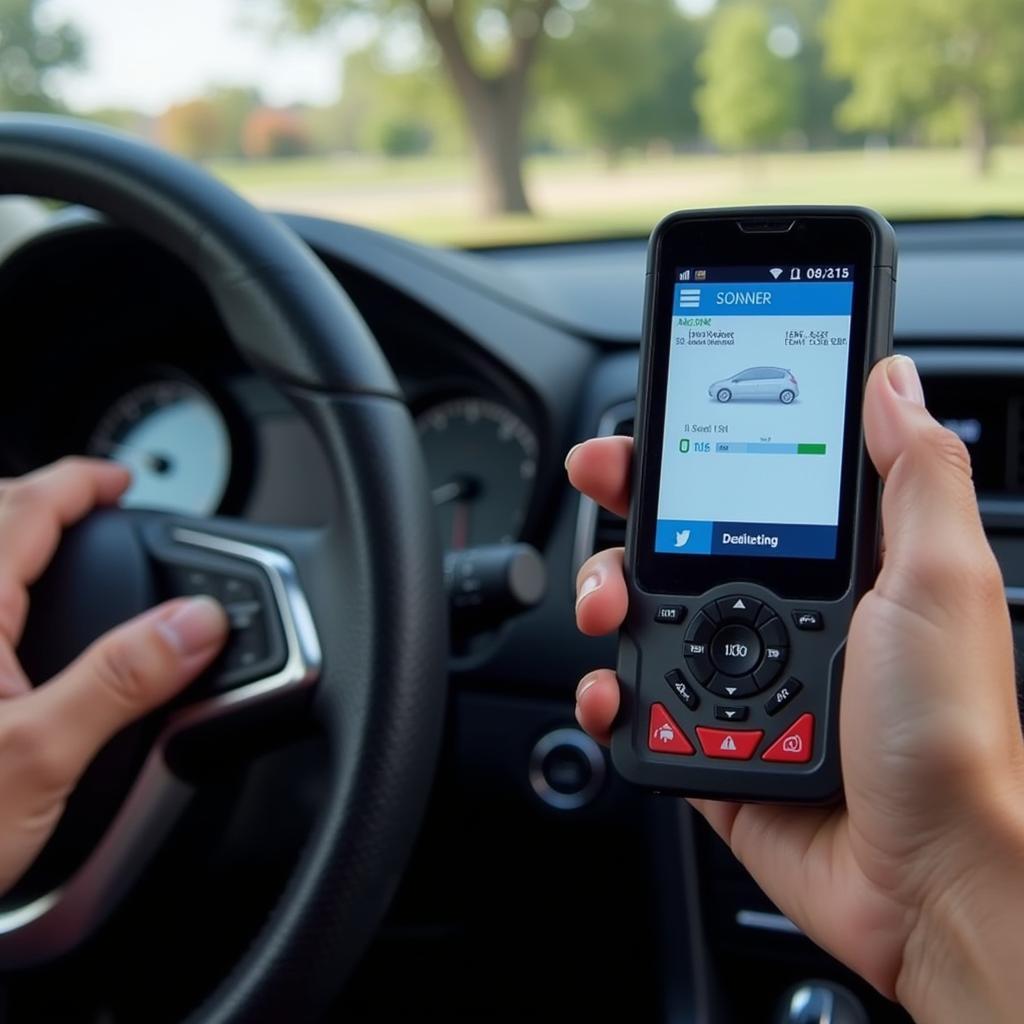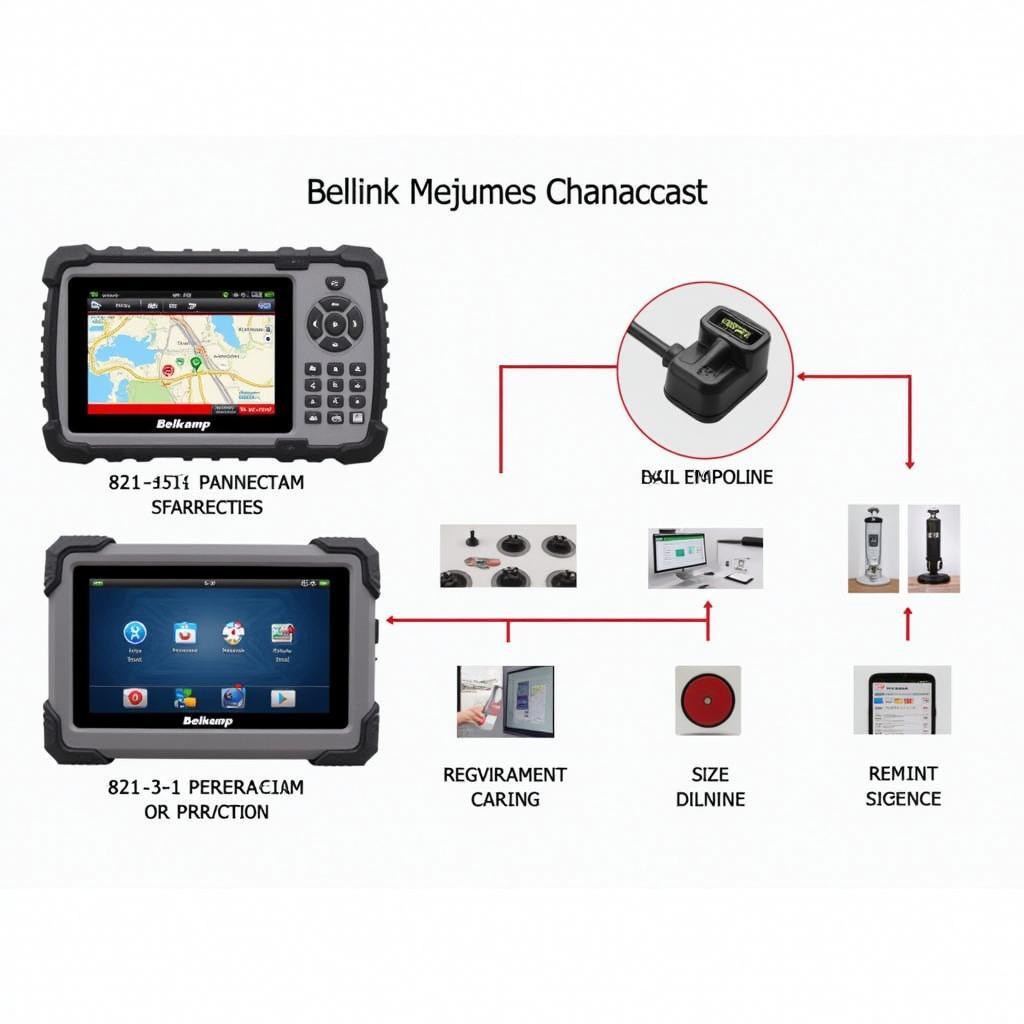A car scan tool, also known as an OBD2 scanner, is an essential device for car owners, mechanics, and DIY enthusiasts. It allows you to communicate with your car’s computer, diagnose engine problems, read and clear fault codes, and access valuable data from various vehicle systems. This comprehensive guide will walk you through the process of using a scan tool effectively, empowering you to understand and resolve car issues.
[image-1|car-scan-tool-connected-to-obd2-port|Car scan tool connected to OBD2 port|A close-up image of a car scan tool properly connected to the OBD2 port of a vehicle. The image should clearly show the connection and the tool’s display.]
Understanding OBD2 and Scan Tools
Before we dive into the “how-to,” let’s clarify what OBD2 and scan tools are all about. OBD2 stands for On-Board Diagnostics, generation two, a standardized system implemented in most vehicles manufactured after 1996. This system monitors various vehicle components and reports any malfunctions by storing Diagnostic Trouble Codes (DTCs) in the car’s computer.
A scan tool acts as the bridge between you and your car’s computer. It retrieves these DTCs, providing valuable insights into the underlying issues. Beyond reading codes, modern scan tools offer a plethora of features, including:
- Live Data Streaming: Observe real-time data from various sensors, such as engine RPM, coolant temperature, oxygen sensor readings, and more.
- Component Activation: Test individual components like fuel injectors, solenoids, or actuators.
- Adaptation and Reset: Perform functions like resetting the throttle position sensor or steering angle sensor.
- ECU Programming: Advanced scan tools may allow for ECU (Engine Control Unit) programming and updates.
Choosing the Right Scan Tool
The market offers a wide array of car engine scanner code reader, from basic code readers to professional-grade diagnostic tools. Choosing the right one depends on your needs and budget.
- Basic Code Readers: Ideal for DIYers who want to read and clear basic engine codes. They are usually budget-friendly.
- Mid-Range Scan Tools: Offer more features like live data streaming, component activation, and some advanced functions. Suitable for car enthusiasts and small workshops.
- Professional-Grade Scan Tools: Packed with features, including ECU programming, bidirectional control, and access to manufacturer-specific data. Designed for professional mechanics and dealerships.
[image-2|different-types-of-car-scan-tools|Different types of Car Scan Tools|An image displaying a variety of Car Scan Tools, showcasing the difference in size, complexity, and features between basic code readers, mid-range scan tools, and professional-grade scan tools.]
For those on a budget, you can even find reliable ebay scanner cars that offer good value for money. Remember, investing in a quality scan tool that meets your needs is crucial for accurate diagnosis and repair.
How to Use a Scan Tool for Cars: Step-by-Step Guide
Now, let’s get to the heart of the matter—using a scan tool to diagnose your car. Here’s a detailed step-by-step guide:
-
Locate the OBD2 Port: In most cars, the OBD2 port is located under the driver’s side dashboard, near the steering column. It’s a trapezoidal 16-pin connector.
-
Turn Off the Ignition: Ensure the ignition is off before connecting the scan tool to avoid any potential electrical issues.
-
Connect the Scan Tool: Plug the scan tool’s connector into the OBD2 port. You should hear a click when it’s securely connected.
-
Turn on the Ignition: Turn the key to the “on” position, but don’t start the engine. This powers up the scan tool and allows it to communicate with the car’s computer.
-
Enter Vehicle Information: Some scan tools may require you to enter specific vehicle information, like the make, model, and year, to establish proper communication.
-
Read Fault Codes: Select the “Read Codes” or “Retrieve Codes” option on the scan tool. It will display any stored Diagnostic Trouble Codes (DTCs) along with their descriptions.
-
Interpret Fault Codes: Each DTC consists of a five-digit alphanumeric code. The first character indicates the system (e.g., “P” for Powertrain), followed by four digits specifying the specific problem area.
Expert Insight from John Miller, Certified Automotive Technician: “Understanding the meaning of DTCs is key to accurate diagnosis. Always refer to a reliable source for code definitions and avoid jumping to conclusions based solely on the code.”
-
Diagnose and Repair: Use the retrieved codes, along with additional diagnostic procedures like visual inspections, to pinpoint the root cause of the problem. Remember, codes indicate a symptom, not always the exact component that needs replacement.
-
Clear Fault Codes: Once you’ve addressed the issue, use the scan tool to clear the stored codes. This resets the check engine light and allows the car’s computer to monitor for any recurring problems.
[image-3|mechanic-using-scan-tool-to-diagnose-car-problem|Mechanic using scan tool to diagnose car problem|An image of a mechanic using a scan tool to diagnose a car issue. The mechanic should be shown looking at the scan tool’s screen while working under the hood of a vehicle, highlighting the tool’s practical use.]
Advanced Scan Tool Features
Beyond basic code reading and clearing, some advanced scan tools offer additional features that can be incredibly helpful:
- Live Data Streaming: Allows you to observe real-time sensor readings, helping you analyze engine performance, diagnose sensor issues, or verify repair work. For example, you can monitor oxygen sensor readings to assess fuel/air mixture.
- Component Activation: This feature lets you activate specific components, such as fuel injectors, to test their functionality without physically accessing them.
- Adaptation and Reset: Use this to perform tasks like resetting the throttle position sensor after cleaning or replacing it, ensuring proper calibration.
- ECU Programming: Advanced scan tools may allow for updating or reprogramming the Engine Control Unit, but this is typically a specialized task performed by experienced technicians.
Remember, not all scan tools offer these advanced features. If you need specific functionalities, choose a scan tool that caters to your requirements.
Common Scan Tool FAQs
1. What is the difference between a scan tool and a code reader?
While the terms are often used interchangeably, a code reader typically only reads and clears basic engine codes. A scan tool offers more comprehensive functionality, including live data, component testing, and sometimes advanced features.
2. Can I use any scan tool for my car?
Most scan tools are compatible with OBD2-compliant vehicles (manufactured after 1996). However, some vehicles may require manufacturer-specific scan tools for accessing certain systems or performing advanced functions.
3. What should I do if the scan tool doesn’t connect to my car?
First, double-check the connection to the OBD2 port and ensure the ignition is on. If the problem persists, check the fuse for the OBD2 port. If the fuse is fine, consult your vehicle’s repair manual or seek professional assistance.
4. Can a scan tool fix my car problems?
A scan tool is a diagnostic tool, not a repair tool. It helps identify issues but doesn’t fix them. You’ll need to address the underlying problem based on the diagnosis provided by the scan tool and your mechanical knowledge.
5. Can I use a scan tool to turn off the check engine light?
Yes, most scan tools allow you to clear fault codes, which will temporarily turn off the check engine light. However, the light will reappear if the underlying problem persists.
Need Further Assistance?
For all your automotive scan tool needs, visit top 10 automotive scan tools or contact ScanToolUS at +1 (641) 206-8880 or visit our office located at 1615 S Laramie Ave, Cicero, IL 60804, USA. Our team of experts is here to help you choose the right scan tool and guide you through any diagnostic challenges.
This guide has provided a comprehensive overview of how to use a scan tool for cars. Remember, a scan tool is an invaluable tool for car maintenance and repair, empowering you to take charge of your vehicle’s health and keep it running smoothly.



Pingback: DIY Tech 2 Scan Tool: The Ultimate Guide to Choosing and Using Yours - Car Scan Tool
Pingback: What is a Good OBD Scan Tool? - Car Scan Tool